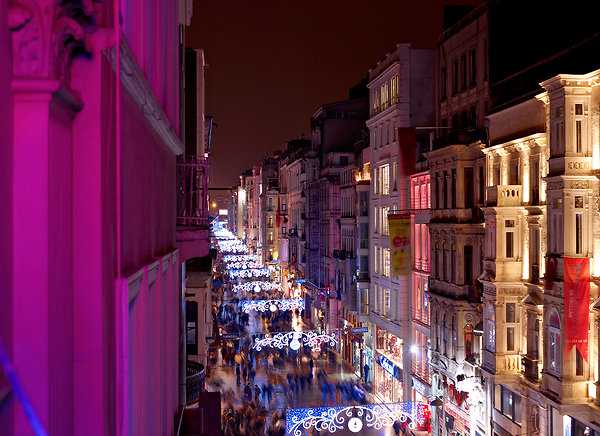
Istiklal Caddesi, the central pedestrian artery of Istanbul. More Photos »
By SUZY HANSEN
Earlier this winter, the giant 120-year-old Ottoman bank building in Istanbul reopened as a multimillion-dollar contemporary art space called SALT. This was surprising. Turks were never big on contemporary art, and for years rich people didn’t visit that part of town. When I moved to the neighborhood five years ago, it was all electrical-supply stores and abandoned buildings and men smoking. My building didn’t have heat; girlfriends wouldn’t visit after dark; a neighbor once attacked another neighbor with a small sword. I don’t see swords in Istanbul anymore. I do see a lot more art.
One evening in November, Turks and foreigners traipsed up the cobbled sidewalks to SALT’s huge, heavy doors for the opening-night party. The headline exhibit featured thousands of old black-and-white photographs taken by a dead Armenian studio photographer and carefully assembled by the young artist Tayfun Serttas. Another exhibit was an installation by Gulsun Karamustafa, Turkey’s doyenne of contemporary art. Another was about archaeology and Europeans looting the Ottoman Empire.
But the space overwhelmed the art. It was too magnificent. Nothing like SALT existed in Istanbul. Inside, the building was five floors and 100,000 square feet of carved white marble. Curators, bankers, interior designers, writers, musicians, academics, artists and wealthy wives craned their necks to take in the soaring ceiling as they climbed the grand staircases. They gaped at the stylish library, and the plush movie theater, and the smoking terrace that was also a restaurant. The great imperial bulk of SALT loomed over the Golden Horn and the forlorn rooftops below.
Foreigners and expats gushed with approval. Even the fatalistic Turks, skeptical of Westerners’ enthusiasm, couldn’t help admitting that this strange art institution was awesome.
It appears that Istanbul, which went from a cosmopolitan wonderland in the 19th century to, in the Nobel-winning novelist Orhan Pamuk’s words, a “pale, poor, second-class imitation of a Western city” for much of the 20th, is having its moment of rebirth. These newly wealthy corners of the East seem full of possibilities, but what kind of culture will the Turks create?
On my way out, I ran into Mari Spirito, a longtime director at 303 Gallery in New York. Spirito had just moved to Turkey to set up a nonprofit called Protocinema. Above our heads, Arabic script was etched into the marble: “He who earns money is God’s beloved servant.”
“In New York it feels like the best years are behind us,” she said. “In Istanbul it feels like the best years are yet to come.”
Those best years might be a long way off, many Turks would joke, but still, it is a heady time to be young and talented in Istanbul. One summer night I accompanied a group of women as they finished their dinner at a meze tavern, put on red lipstick and stopped for a bottle of raki (Turkey’s national liquor) and cigarettes on their way to a party not far from SALT. Especially on muggy evenings, Istiklal Caddesi, the central pedestrian artery of the city, swarms with people, bodies colliding as Turks and tourists race to shops, cafes and bars. Arms around one another, the women maneuvered through Istiklal’s traffic into Rumeli Han, an Ottoman-era arcade building that exudes a faded, dingy glory, with sooty stone staircases and crumbling ceilings. Up a few flights, past the Communist Party office, music drifted out of an artists’ studio. Beer bottles and cans covered the table and floor; a stack of easels leaned against a wall; the girls poured their raki into tiny plastic cups and found a seat with their friends.
“This place has become a meeting point,” one gallery owner said. “It’s feeding the underground scene.”
In a long room, about 40 Turks were watching the performance group Ha Za Vu Zu play music. The 20- and 30-somethings sat on the floor and listened quietly. Some women wore retro styles, ’40s hair and cigarette pants. Men with poofs of black curls lounged in T-shirts. A pretty girl in a sundress thrust an invitation into my hand. “I’m having my first show!” she said. The venue was the prominent exhibition space Arter. “Please come.”
The artists then began dancing to old Turkish rock, a hybrid of Western and Anatolian music, joining together in a modern version of traditional Turkish dancing: arms spread wide, women and men dancing together in pairs. The vibe was anything but self-conscious; it felt like a safe place to go nuts. Shoes came off, feet turned black. After a few hours, sweat pouring down their faces, the men took off their shirts, shouting, laughing, stamping. Someone danced into a heart-shaped ashtray, spilling cigarette butts on the floor; a woman took off her shirt, too.
via The Istanbul Art-Boom Bubble – NYTimes.com.
more:

Leave a Reply